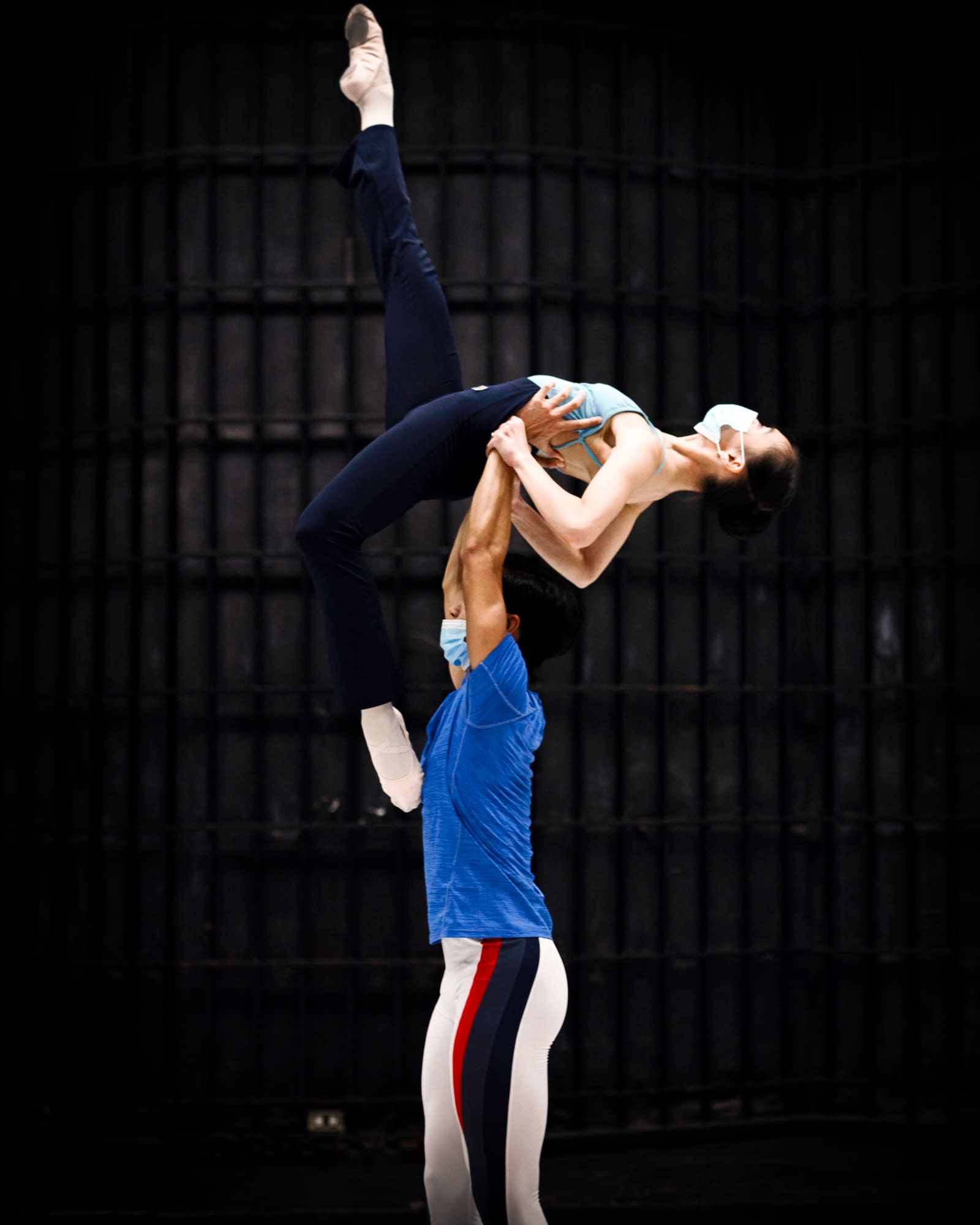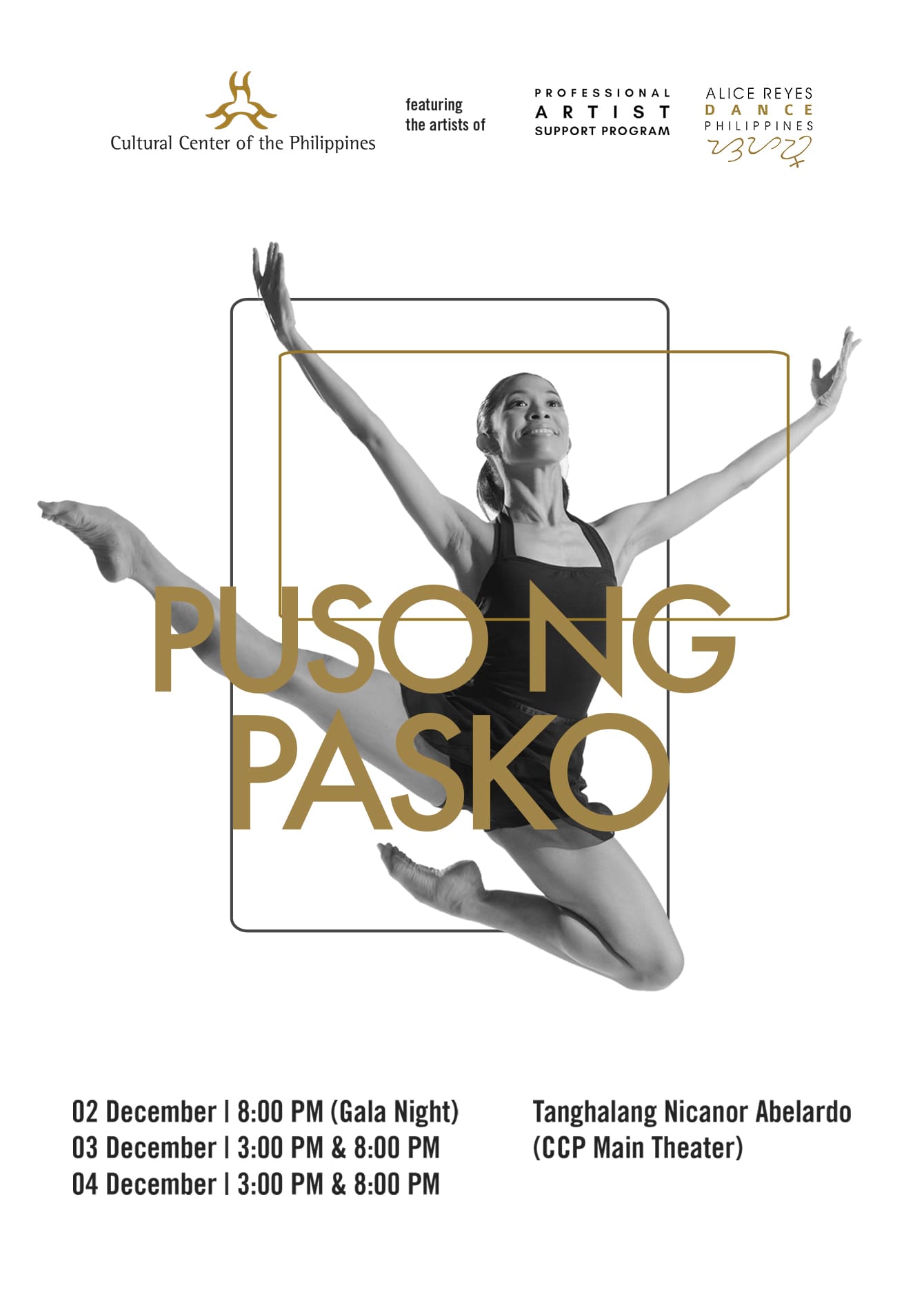National Artist for Dance Alice Reyes. Dookie Ducay
The Philippines has an all-Filipino full-length Christmas ballet.
In a small studio inside the Cultural Center of the Philippines (CCP) in Pasay City, a group of young ballerinas and danseurs evoke the spirit of Christmas. It’s mid-November. The songs blasting from the speakers—a seamless fusing of upbeat carols and sentimental melodies—already bring to mind traditional Filipino festivities that include door-to-door caroling, meeting up with friends for the Simbang Gabi (a traditional nine-day series of Catholic masses), streets lined up with parol (lanterns), and thoughts of the delicious smell of delicacies, puto bumbong and bibingka. As all Filipinos know, no celebration is bigger than Christmas.
The magnitude of the production, however, is coherent with the minds behind it. The dancers all belong to the Alice Reyes Dance Philippines (ARDP), founded by National Artist for Dance Alice Reyes. The music was arranged by National Artist for Music Ryan Cayabyab.

The show is called Puso ng Pasko, an original full-length all-Filipino ballet, based on the dance film production, Tuloy ang Pasko (2020). In some perspectives, it is the answer to the Filipino adaptation of Pyotr Tchaikovsky’s The Nutcracker, which has become an annual offering of the CCP.
“It means a tremendous amount to me because you’re now seeing the truth of what immense creative talent and performing talent can do,” Reyes tells Vogue Philippines of the upcoming show. “And this is the second generation. This is not my choreography, but I’m excited about this as I would be and I’d be as involved as I would be if it were mine.” Reyes serves as the mentor and artistic consultant.
While the show simply adapted Cayabyab’s songs from his 2005 albums Pasko 1 and Pasko 2 (performed and recorded by the San Miguel Philharmonic Orchestra and the San Miguel Master Chorale), the maestro will be at the live performances as conductor of the orchestra and the choir.
“The goal is to give Filipinos a choice of new ballet presentation for Christmas,” Cayabyab says of Puso ng Pasko. “It’s also where families can go and watch a delightful show. The subliminal goal is that we are pushing for Filipino creativity and songs that were written by Filipinos.”
ARDP artistic director Ronelson Yadao brings the story to life, and is joined by Erl Sorilla, John Ababon, AL Abraham, Dan Dayo, Bonnie Guerrero, and Lester Reguindin.
“I know two things: whatever happens, tuloy ang Pasko and the Filipinos will celebrate it, so based on those two, I said, ‘I want to do a musical number based on the Filipino belief in Christmas and one that will cheer people up.’”
A show of camaraderie
Puso ng Pasko is set in the ’70s and begins with the story of Lolo Val, a Filipino living in the United States, as he tries to set a Zoom reunion with his old pals. As the story progresses, Lolo Val shares with his granddaughter, Angelita, his poignant memories of Christmas with his friends. As joyful tales go, it revolves around love, friendship, and family—not a distant concept for the talents doing their gallops and pirouettes right in front of us.
At the height of the pandemic, these dancers were displaced. Yadao recalls, “Being a national artist and also a mother, Alice Reyes took us in. And ultimately, she wanted us to continue our training because dance is very physical and is space-oriented. You can’t just do it at home. Through CCP’s arts education programs, we were able to have our space here, and we were given projects for online content during the pandemic.”
In fact, before this full-length ballet came into fruition, the same group successfully pulled off the shorter Tuloy Ang Pasko, which literally translates to, “Christmas will push through,” the idea behind show.
“I know two things: whatever happens, tuloy ang Pasko and the Filipinos will celebrate it,” Reyes explains. “So based on those two, I said, ‘I want to do a musical number based on the Filipino belief in Christmas and one that will cheer people up.’” To prepare, around 16 dancers “camped” inside Reyes’ home for months. Everyone not only continued training and practicing, but also learned how to cook from Reyes herself.

“They’re all very intelligent, but you can only take so much classes,” she recalls, laughing. “I had to keep them challenged and active in the house. I like cooking. Sometimes, I will read cookbooks to relax myself. So, I would come up with recipes and I would challenge them.” By the end of the “locked-in training sessions,” the dancers had learned how to make bechamel sauce, hollandaise sauce, and eggs benedict, to name a few. They have also invited people over at what they now call, “Casa AR.” The experience not only deepened everyone’s understanding of the kind of show they wanted to produce, but it also strengthened their bond. “They are so, so wonderful,” concludes Reyes.
On the topic of bonds, the choice of music came as gracefully as its creator. Cayabyab and Reyes have known each other since the late ’70s, and, according to Cayabyab, they cemented their friendship during the making of the highly acclaimed, Rama, Hari, which was inspired by a Sanskrit epic. The show—a collaboration among Reyes, Cayabyab, the late Bienvenido Lumbera (National Artist for Literature), the late Salvador Bernal (National Artist for Theater Design), and the late Rolando Tinio (National Artist for Theater and Literature)—premiered in February 1980.
Fast forward to 2020: Reyes was at the onset of creating a Christmas show, and she immediately thought of Cayabyab. Yadao recalls, “We’re familiar with Mr. C’s songs, of course. So we asked him if we could use his music, or if he could at least create a transitional music. Little did we know that he had two albums that contained a range of Christmas songs.” That time, they were all busy trying to survive the pandemic, that Cayabyab suggested they chose a few songs that complemented the dance movements.
“With the use of technology, the movement can be adapted better—if the song faster, for example,” Cayabyab says. “That’s what they did. They tweaked the songs. There are some parts of my music that they edited, so it’s not a full song.”
Eljay Castro Deldoc worked with Yadao on the script and story as co-librettist, and veteran film director Carlos Siguion-Reyna gave input on the filmed scenes to create a masterful ensemble onstage.

In retrospect, it was a seamless series of discussions between the two National Artists. “Ryan is so easy to talk to,” Reyes says fondly of her friend. “And he’s so generous in spirit. Plus, the music is so wonderful. We’ve just kept working and working.”
Besides, Cayabyab admits, he can’t stand being idle. “Malikot utak ko,” he says, smiling. As for his friend, he says she might be 12 years older than him, but he finds her energy enviable. “Malikot din utak. And she can do so much more,” he exclaims. “I hope to be like her in 12 years.”
When Reyes hears this, she laughs before blurting out, “He will be. He’s so prolific. So generous. I think he and I can both be proud of the products that we have put out. I’ve worked with dancers, choreographers, and teachers. He has produced so many singers, musicians, composers and so forth. I think we both share that joy.”

Puso ng Pasko, featuring artists of CCP’s Professional Artist Support Program and Alice Reyes Dance Philippines, runs from December 2 to 4 at the CCP Main Theater. Tickets are available here or through the ARDP Ticketing Officer via 09154122152.
Photography: Dookie Ducay, Sittings Editor: Alyssa Lapid, Makeup: Don de Jesus, Hair: Mong Amado, Producer: Anz Hizon, Bookings Associate: Bianca Zaragoza, Photographer’s Assistants: Mark Catunga, Byron de Guzman
